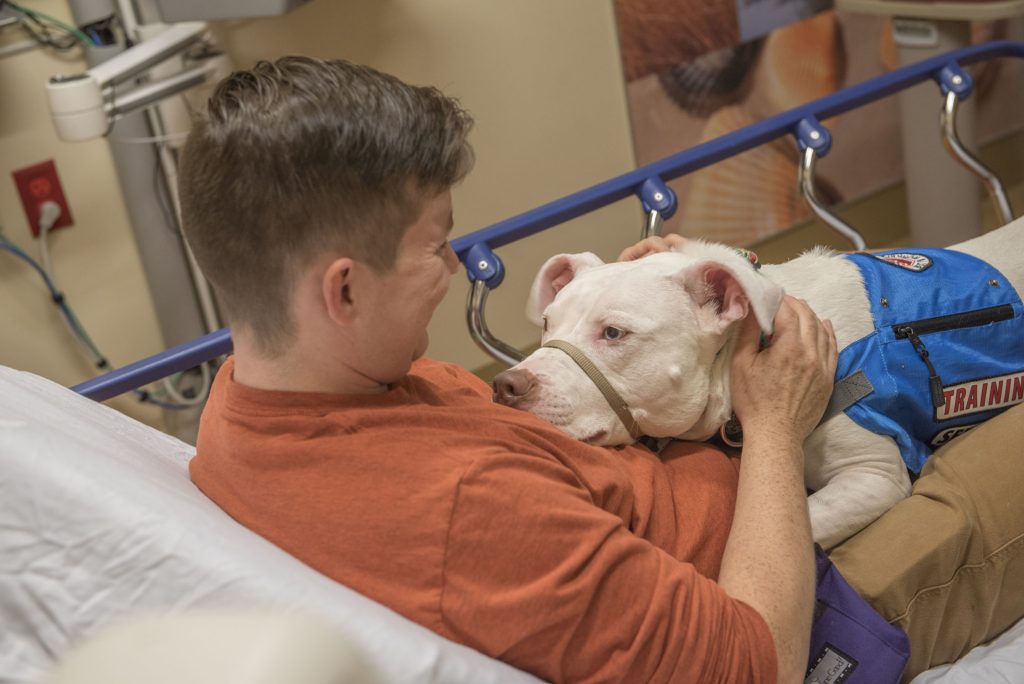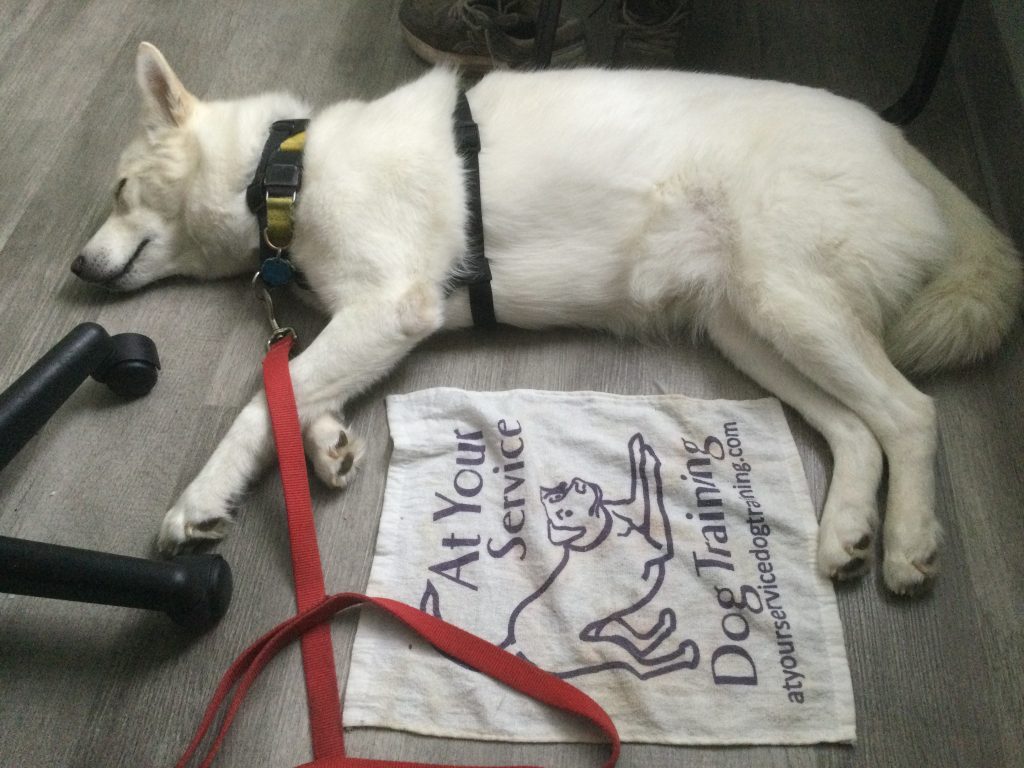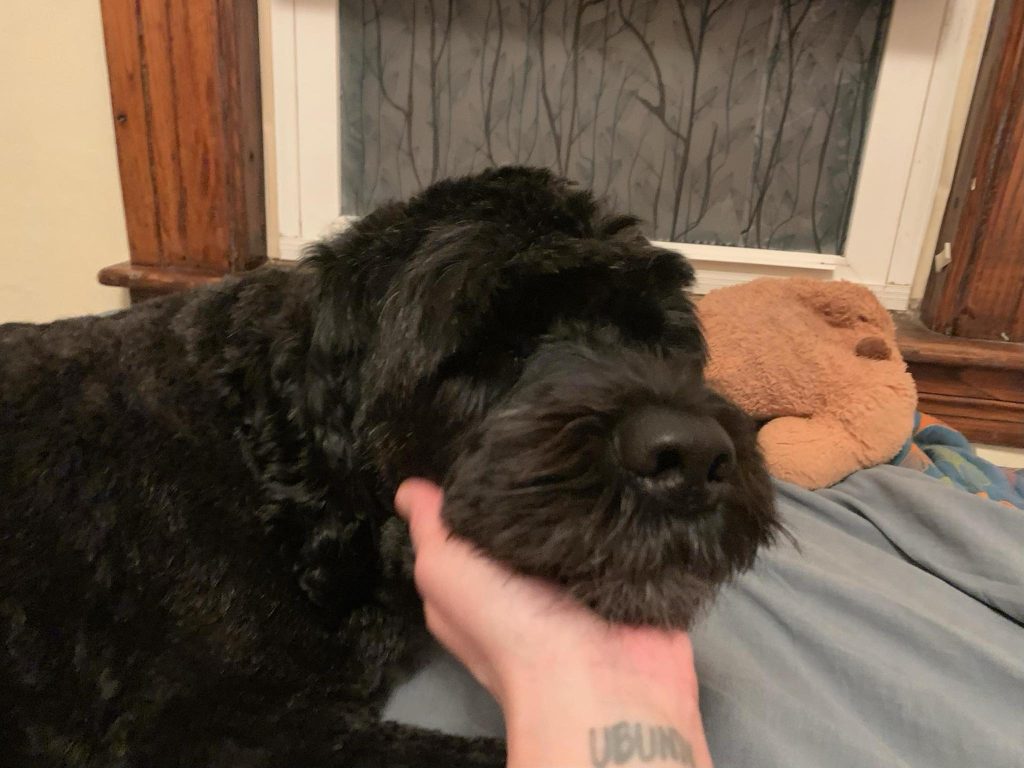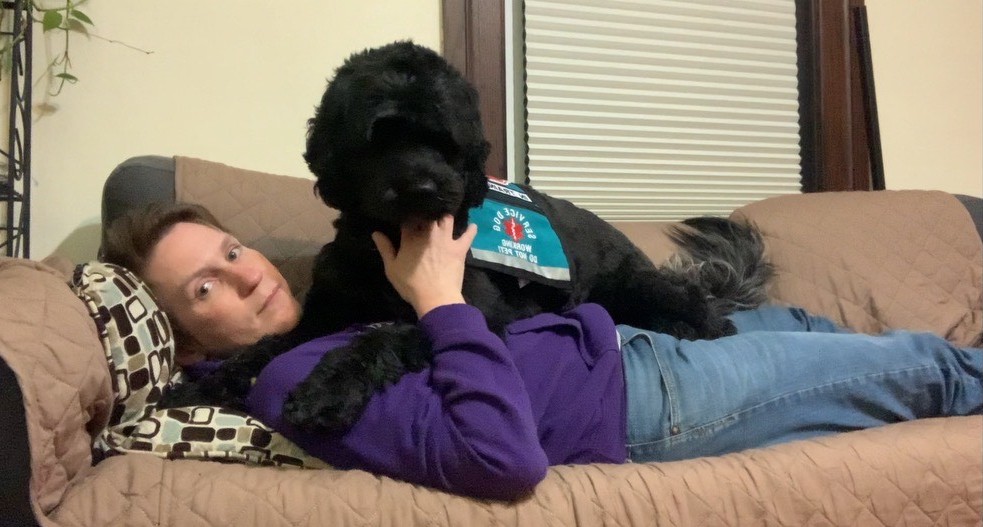Deep pressure therapy (DPT) is a highly useful task for people who are training their own service dog — for themselves or their child. DPT is useful for multiple types of disabilities, including PTSD, depression, panic and anxiety disorders, autism spectrum disorder, ADHD, arthritis and other pain syndromes, seizure disorders, and more.
Your dog may naturally like to jump in your lap when you’re watching TV on the couch. But your ESA, service dog, or service-dog-in-training (SDiT) may not be able to do that when you ask, or when you’re in a grocery store or your doctor’s office. Or your dog may not know how to lie across your chest or legs — and stay there. Some dogs are not “lap dogs” to begin with.
Is it still possible to train your dog to provide deep pressure therapy if they don’t do it naturally? Yes! In both private lessons and in our online Deep Pressure Therapy course, we have trained with a great variety of dogs. We have seen success with dogs that are not naturally cuddly going to a dysregulated child to offer comfort or lying on an adult handler during the onset of symptoms.

Even if you have a dog that is not suited to public access, due to discomfort with strangers or loud locations, your dog can provide deep pressure therapy at home as an ESA (emotional support animal).
You, too, can train your service dog or emotional support dog (ESA) to provide DPT for you in a variety of situations, even if they are not natural lap dogs. Here are five tips to help you get started:
- Build foundations slowly
- Train a “settle on a mat” behavior first
- Get your dog used to standing and then lying on unstable surfaces
- Build duration slowly
- Make sure your dog always recognizes its release cue
Foundation: Slow Is Fast

The best training is “errorless learning,” meaning that we make training so easy for our dog when we’re training a new skill that they never make a mistake. Of course, in practice, this is very difficult and requires a great deal of skill. But, we can do our best to set our dog up for success so that they are consistently successful. The key is to only add the next step a little bit at a time, when the dog is correct at their current level many times in a row.
The challenge of training this way is that it may mean that you are working at a lower level for a long time. But that’s actually how professionals train dogs.
For example, before we train a dog to lie on its handler for several minutes, we first make sure it knows how to lie on other lumpy and “strange” surfaces, as well as reliably knowing how to stay on another target for much longer than needed for DPT.
The benefit of training that’s very easy for your dog to succeed every time is that when they do get to the more difficult levels, your dog has significant experience to draw on. This means fewer mistakes, misunderstandings, or backsliding when it really counts. By going slow, and meeting your dog where they are at in the moment, you end up with a more reliable behavior that needs fewer fixes in the long run. Slow is fast!
Relax on a Mat

“Why do I need to teach my dog to lay on a mat? I want them to lay on me!” This is a common question. The answer is that if your dog already knows to go lay down on a target, then you can easily “explain” to your dog that you want them to lie on you by changing where the target is!
Note: For a DPT foundation, train your dog to lie on something small, light, and portable, like a hand towel. We provide our clients with little “settle towels” that can be folded and fit neatly in a blue jeans pocket.
Laying down on a person feels very different from laying on a floor or a dog bed or mat. If you have an existing method to communicate to your dog “I want you to lie down here,” you now have a big advantage in teaching a “lie down on me” behavior. Especially if you have spent time teaching your dog that putting their paws on people is rude, the mat can bridge that communication gap and more clearly signal to your dog what you are asking of them.
Condition to Unstable Surfaces
Our human bodies are not stable surfaces! We may shift, shake, or huff and puff, even at the best of times, when we aren’t experiencing a medical episode! Added to that, we have bones and various other lumps, bumps, and valleys that make us uneven surfaces.
An effective deep pressure therapy behavior needs to continue, even if we are shivering or rocking or one part of our body is lower than another. To succeed with duration DPT, our dogs need to be comfortable with remaining in place, even if that place is moving or uneven.
Build your dog’s confidence by introducing them to inflatable exercise equipment, piles of blankets and towels, or wobbly platforms. Reward them for interactions at first, then for stepping on them. Work up to asking for behaviors, sits, downs, etc. once your dog feels good getting onto and walking across the surfaces.
Build Duration
Building duration for DPT is much the same as duration for other behaviors. We want to slowly build up our dog’s ability to hold their position. Once your dog is accurately offering the behavior, start delaying your marker two seconds, three seconds, four seconds, then back to two seconds! Trend upwards, but bounce around. Give your dog easy wins as you build their capacity for difficult wins.
If your dog breaks, notice at what duration that happened, and work below that, building back up to that point.
Clear “Release” Cue

Here’s a surprising reason that many service dogs don’t have a reliable “stay”: It’s because they don’t have a reliable release! To have a reliable “stay,” your dog needs to know the cue that starts the behavior (e.g., “Sit” or “Down” or “Go Settle”) and they also need to know when the behavior ends! If your dog is releasing itself, it may be because they are following other cues they think mean the behavior is over — such as getting a treat, you looking away, you moving, etc. Remember to release your dog!
Spend time training your dog on their release cue as its own distinct behavior before you start training duration in a sit, down, or deep pressure therapy behavior. A cued release tells your dog exactly when they are done and helps prevent them from releasing themselves. This is a point in your training where “slow is fast” is particularly relevant. Building duration takes time, but the more history your dog has of successfully holding a behavior until released, the more your dog will succeed with staying put in the future.
Looking Ahead
Alright! Your dog has a sustained DPT behavior: they’re responding on cue and holding until released. What’s next? Here are some considerations.
Subtler Versions of Deep Pressure Therapy for Public Access Situations (Chin Rest and Kisses)
Are there times you might want your dog to provide some contact without it looking so obvious? For example, in our DPT class, we also teach behaviors like chin rest (train your dog to rest their chin on your thigh, hand, or foot) and kisses (train your dog to lick your face or hand). You can combine these behaviors with a full DPT behavior — so your dog is lying on your chest and licking your face, or lying on your legs and resting his head on your chest. Or you can train them as separate skills to use as needed.


Distraction and Generalization
Distraction and generalization are the key next steps. In a real life scenario, outside of a training session, your dog may need to use their deep pressure therapy behavior in highly distracting environments. Onlookers or concerned passersby might approach to talk to you or your dog. Perhaps you’re in a park with joggers or food carts or other dogs! Lying on you, relaxed, in those environments is very different from doing it at home.
Start incorporating distraction into your training sessions. Start small, start easy; remember, slow is fast! Think about what your service dog would most be distracted by and incrementally work up to that. Have something interesting on the other side of the room or on the other side of a glass door or window. Have a recording of dog sounds play at a low volume several feet away from where you’re working with your dog.
As your dog succeeds, bring the distraction a foot closer or make it a click louder or make it move just a little bit. Practice in different rooms of your home, in the yard or driveway or parking lot, at a familiar park, at an unfamiliar park, at the store, the post office, the bus station. Remember, when you start training in a new location, go back to an easier level. If your dog is responding to a verbal cue at home and holding for a two-minute duration, when you start training at the coffee shop, use just a physical cue and hold for maybe only 15 seconds to warm up. You can build back up to that level once your dog shows you they can be successful in this new environment.
Our Dogs In Service Certification (DISC) courses specialize in teaching you how to apply these concepts to your dog training. Our focus is on helping disabled handlers or parents of disabled kids become very skilled at training your own service dogs. Learn more about the DISC program.

Get Support to Help Your Dog Help You!
If you’d like more help with training your service dog’s reliable, duration deep pressure therapy behavior, check out our Deep Pressure Therapy class! This online class is taught LIVE online with Zoom by a service dog trainer who will offer personalized coaching for you and your dog. Classes are kept very small (usually just four dogs). It also covers “kisses,” chin rest, and beginning symptom-cued behavior. You’ll also get helpful written homework instruction, a video recording of each class, and you can enjoy watching and learning from the other SDiTs and service dog partners in the class. Learn more about the deep pressure therapy class and register here.
Here’s what others say about our online classes:
Comprehensive and Affordable. Before class, I was overwhelmed and discouraged by all the things my dog needed to learn. I didn’t know how to go about structuring a program that would be the right pace for him. The instructors are knowledgeable and experienced, but also patient and kind. The small class size allows for plenty of individual attention. The live Zoom format was almost like being in a group class, but without all the distractions of the other dogs. I learned a lot from watching coaching and discussions with the other members of the class. It was a lot more personalized than the online self-study programs. — AT & Zephyr, New Hampshire
My favorite part was the coaching while we were trying the tasks with our dogs. Even when we were watching others being coached, it helped. I also really appreciate the thoroughness of the materials we got after class. I read through and watched all assigned tip sheets and videos. It was very helpful. I appreciate being able to go back and review and understand each lesson. — Kate & Joy, Massachusetts
https://atyourservicedogtraining.com/how-to-train-your-service-dog-in-deep-pressure-therapy-dpt/
